Great analysis tools like Google Analytics provide great statistical data about website visits, conversions, or CTRs. But they won’t tell you the “why” behind users' and visitors' behavior.
To get this information, you have to ask - and gather a mix of quantitative and qualitative data. Surveys are a great way to do this, especially if you do it at the right time - when respondents have the incentive to let you know their thoughts.
That's why it's so important to run website pop-up surveys and start collecting enough answers to take your business and customer analysis to the next level. Collected insights reveal what stops visitors from converting and what they think about your website, service, or product.
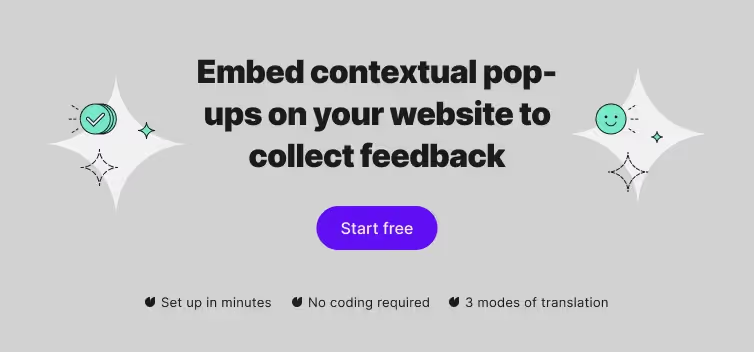
Running website popup surveys are also easy to implement on the website - just a piece of JavaScript code. Let's dive into a topic.
What is a website pop-up survey?
Website pop-up surveys are also referred to as on-site or on-page surveys. These are, naturally, surveys you run directly on your website and often relate to the content on hand.
There are multiple types available, with pop-up surveys being the most effective. They allow you to collect feedback directly from your visitors, understand their behavior and motivations, and find out how they respond to your content or offer.

A website pop-up survey
- requires minimal effort to complete
- does not disturb the visitor with a new browser window opening
- does not direct the visitor away to a different page
in contrast to website intercept surveys.
The visitor can simply answer a short question on the side or leave a comment. No personal information is required hence the visitor is more likely to respond if they are concerned with privacy.
Generally, the potential for collecting feedback with website surveys is significantly larger than with other survey types, especially since it doesn't require an email database to distribute.
Showing the survey to all visitors on your website means you can expect hundreds of results quickly (although we do not recommend it, more on that later).
Why is using website pop-up surveys important?
Website surveys can fill in where Google Analytics can't and help you understand why visitors behave as they do.
They can be used in many ways to find out why visitors are doing actions you expected them to or to generate leads. Below you can find some potential use cases:
- Collecting feedback on recently redesigned pages (here's a real-life case study about improving the design of a website)
- Discovering what potential customers of your e-commerce would want you to offer (here's a real-life case study about how to find new business opportunities with website surveys)
Post-purchase surveys to discover friction points on your purchase path and fix them to increase conversion rates and sales (real-life case study about how to improve e-commerce website with post-purchase surveys)
Tools like Survicate let you ask context-specific questions directly on your site—at just the right moment. Whether you're improving UX, reducing cart abandonment, or testing a redesign, real-time feedback helps you understand why users behave the way they do.
- Website exit survey to find out why visitors are bouncing off your page
- Website usability survey to spot and fix usability issues
- Navigation survey to improve website navigation, one of the crucial factors contributing to usability
- On top of that, with our integrations, you can use surveys to qualify and generate leads and send them straight to CRM’s or Marketing Automation platforms
Website pop-up survey best practices
1. Start with defining a goal of running your website survey
To survey your users effectively, you first need to decide what the purpose of your survey is. The great thing about a survey is that you can ask a wide range of questions that don’t necessarily have to be related to one another, but you should have a goal, or a few goals, for your survey so it doesn’t become an endless stream of questions.
Think about what you want to learn before you start your first website survey.
Goals popular among Survicate’s customers include:
- learn what products or features visitors want you to offer
- what stops them from buying
- how they assess a new design, what they would improve on a page
2. Choose the right question type
You can choose between multiple question types, including multiple-choice, single-choice and text answers. While text answers might provide you with the most interesting answers, they are also more difficult to analyze in large volumes and report lower survey response rates compared to radio boxes or checkboxes.
What you can do about it: at the beginning of a survey campaign, ask for text answers. Survicate uses a word cloud that will make finding these patterns a breeze.

Find common answers and turn them into answers in single or multiple-choice questions to make analysis easier. Our suggestion feature will help you write questions based on the survey content you already have.
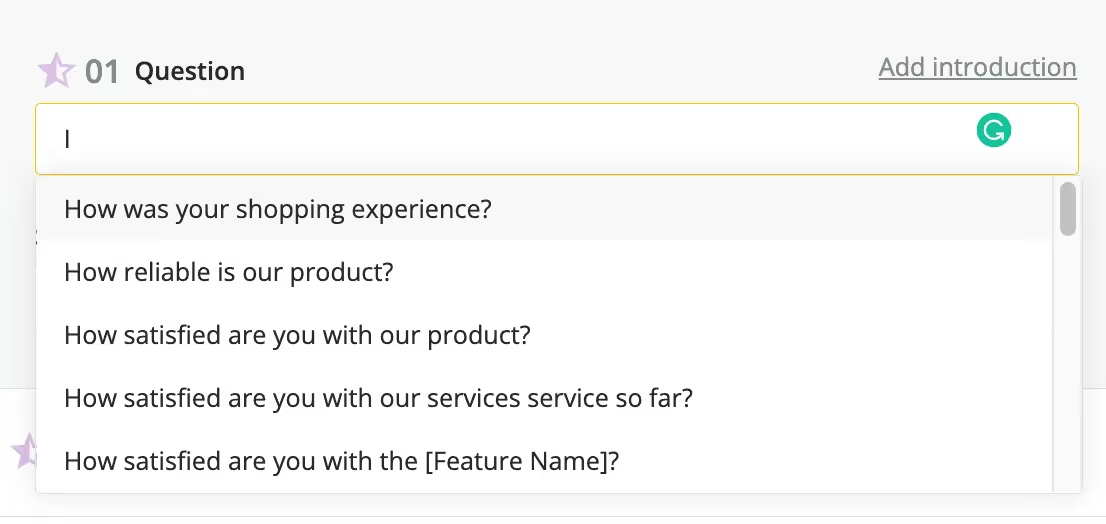
What’s more, we have over 125 survey templates optimized for best results.
And you can always add an option to add a comment to closed responses. Take a look at the 20 most popular website survey question examples.
All survey questions must be easy to understand and presented at the right moment, which leads us to the second factor crucial in a successful survey, which is utilizing targeting.
3. Utilize targeting
Advanced targeting allows you to choose who will see survey widgets and when so you can adjust the message.
Example: when you want to investigate why people abandon shopping carts, run a survey to target only people who added something to the cart and are about to leave the page.
Survicate targeting options include:
- sources of traffic (direct, organic search, campaigns, referrals, etc.)
- page URL – you can set the website survey to appear only on a certain page or pages
- new or returning visitors (possibility to show surveys to users returning for the X’th time)
- browser language and geography
- device – mobile, desktop or both
- specific behavior: time on page, % of the scroll or exit intent.
Using those options, you can precisely choose who and when will see the popup survey. It allows you to personalize the message by combining targeting options.
Example: You can ask visitors landing from a partner page about what services they expect to find. If a visitor spent a significant amount of time on your page, you can ask them if they would be interested in a demo call.
If you run a SaaS company, you can ask new users what industry they come from or what other SaaS tools they use, while visitors that are returning for the 5th time see a question asking about features they would want to see.
4. Design widgets to match your website
Survicate surveys start with a simple design that matches most websites.
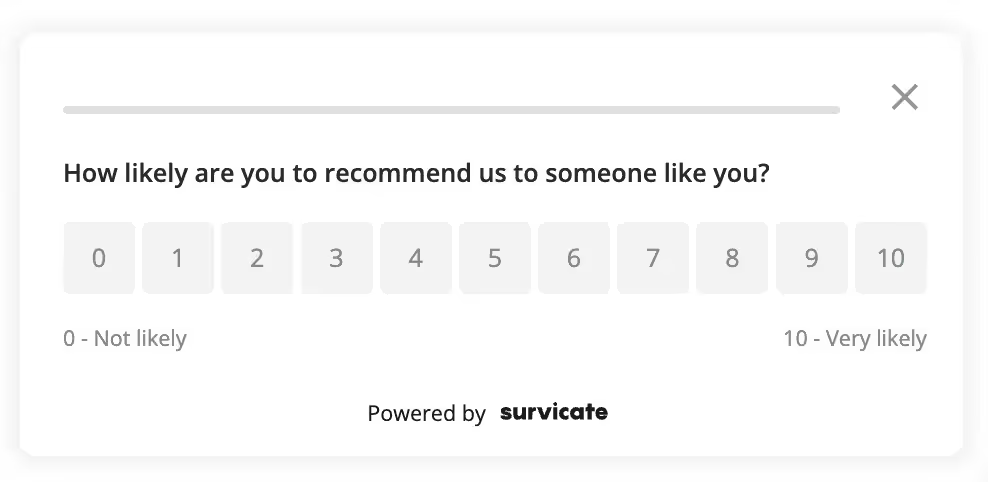
You can also take advantage of our extensive themes gallery.
However, sometimes it’s worth changing them at least a bit to make the survey even more appealing to your visitors. You can alter fonts, colors, backgrounds, and play around with the transparency of the pop-up.
Just remember one thing: widgets should be easily visible. Why? An example of one of our clients: their website was mostly white, and they changed the widget design to white. As a result, barely anyone noticed them. Making widgets slightly darker increased response rates immediately.
And remember to place your pop-up surveys strategically. You don't want them to intercept what a customer can do on your website. Annoying and obtrusive designs can lead to inaccurate data (customers trying to push through the survey to use your website) or even website exit (users become frustrated).
5. Regularly review results
Website surveys are not meant to be fired and forgotten. Analyze your results regularly to see what visitors are saying and how your surveys perform. To make it a part of your weekly routine, you can set up reports with an overview of your results to be delivered straight to your inbox.
6. Act upon collected data
Website surveys allow you to learn about your visitors and customers. But the key is to use collected insights to introduce changes on the website or in the communication strategy.
Example: when you find out that people abandon carts because of lacking a shipping cost table, add a table and see how it affects their behavior and answers to a new survey.
How to analyze website pop-up survey data
The key to a successful website survey is analyzing the data obtained with a pop-up and taking appropriate actions.therwise, running website pop-up surveys won’t benefit you much.
When you collect a meaningful dataset (in most cases, 50-100 answers are enough to spot trends), analyze the responses and draw some conclusions. Then turn conclusions into decisions.
If the results suggest that something should be changed on the website, implement a change, and observe the results.
Furthermore, you can use integrations to send collected data to a CRM, marketing automation, or an analytical tool like Google Analytics. What’s in it for you?
Integrations with CRMs and marketing automation solutions allow you to collect leads generated through website surveys and enrich your profile database.
Using Survicate x Google Analytics, you can build custom segments based on visitors' answers. Custom segments can be used for more in-depth analysis and for building retargeting lists.
Advanced applications of website pop-up surveys
Analyze results in Google Analytics
How do you analyze the results of your website surveys? I bet you do it within your tool's dashboard or download .csv or .xls files to analyze them on your computer. There’s nothing wrong with that, I do it myself. But have you ever wondered how people who answer surveys behave on the website? I have. And I use Google Analytics integration to find it out.
This integration allows you to see responses to surveys (they are sent as events). You can create segments of website visitors who engage with surveys and see how they behave compared to all the others. You can also see which traffic sources bring people more likely to answer surveys.
Use CRM and marketing automation integrations
Most users use website surveys to collect feedback from website visitors. But you can also use them to collect contact data to turn website visitors into leads. Two-way integrations allow you to send leads collected with a website survey tool to CRM or marketing automation solutions.
What’s more, you can even use website surveys to enrich profiles of leads already stored in external tools, like Pardot, Intercom, HubSpot, ActiveCampaign, or several other tools integrated with Survicate.
Example: you can use our Intercom integration to add answers to surveys as tags, events, or notes to profiles of your customers or leads. Result? The possibility of sending more targeted messages and creating a personalized onboarding flow.
Lead alerts
If you want to use Survicate or another survey tool to generate leads on your website, you can also use lead alerts. What are they? Basically, you receive an email every time a person completes a lead form. Thanks to that, you can react quickly and contact your new lead. Easy to set up but often overlooked.
Tagging
Don’t you think it could be useful to ask questions only to visitors who answered one of the previous surveys?
Let me explain with a simple example: you’re planning to redesign a website. So you can run a survey to determine what people think about the current design and how they assess it on a scale of 1-10. Let’s say a person answers that the navigation is a bit unclear and gives an overall score of 8. Wouldn’t it be valuable to ask this person similar questions after the redesign? It would show you which changes affected user experience in a positive way and which did not so much.Use tagging to do it. Tag people who participate in the first survey. Then you can use those tags to target visitors with another survey.
Tip: you can also use tags to exclude certain groups of visitors from taking part in a survey.
Single Page App targeting
Single Page Apps are getting more popular, but not all website survey tools seem to notice it. So if you have a SPA, ensure the website survey tool you choose supports it, as Survicate does. What’s in it for you? You can precisely target surveys to visitors who are using a certain section on the website.
Example: We use SPA targeting to survey our users and collect their feedback on specific app sections, like creating survey logic. What’s best, is when a person navigates from this section to another, the survey can disappear if you want it to.SPA support is especially valuable for SaaS - they can run surveys on websites and inside apps.
A/B testing of survey widgets
All A/B tests have one goal - ensure you achieve the best results possible. It usually applies to websites or ads, but you can also do it with website surveys. You can create 2 or more widgets with the same goal but different targeting or copy to see how it affects response rates. Result? More answers from the same amount of website traffic.
Cookie targeting
Let’s say you have a SaaS app and want to survey only paying customers to ask them a specific question. How can you do it? Targeting surveys to appear only inside the app won’t be effective - there will also be people on trials or free accounts. But if you assign a cookie to pay customers, you can use it to target them. This method is 100% accurate, and you can use it to target any groups of visitors or customers, paying customers is just an example - everything depends on how you use cookies.
Learn more about cookie-based targeting.
Response rate from website pop-up surveys
Usually, Survicate users report response rates between 3-5% without using targeting. However, when targeting options are fully utilized, response rates can be as high as 58% (post-purchase surveys typically get the most responses).
When targeting is not used, and all visitors see a survey right after landing on your website, response rates stay at around 1%. Hence we discouraged it earlier.
Of course, the number of answers also depends on the traffic to the website – a highly trafficked website will collect more answers with a response rate of 1% than a small website with a response rate of 60%.
We recommend experimenting with targeting and some more advanced options rather than showing a survey to all visitors entering the website – this provides a higher quality of collected insight and a better user experience for visitors who see only relevant questions.
To ensure you use the right questions and targeting options, think hard about what feedback is most valuable and what kind of targets can give it to you.
Play around with targeting to see which settings provide the highest response rates so you can maximize the number of collected answers.
Who can benefit from running a website pop-up survey
Lead
In smaller companies, owners or marketing specialists often use website pop-up surveys – not a big surprise as we all know that working in a small company requires multitasking. Such companies can use website pop-up surveys to gather useful insight into their offer, website usability, design, etc.
Since changes can be implemented quickly, the owner can perform them themselves. If they hired a good marketer, they will often be responsible for minor changes to the website and communication strategies, so insights help them get their jobs done.
But who can use and benefit from website surveys at big companies with a strict division of responsibilities and tasks?
Conversion rate optimization specialists
What’s included in a toolbox of a conversion specialist? Usually, an analytical tool like Google Analytics, A/B testing tools like Optimizely, heat maps like CrazyEgg, and session recordings like FullStory (we have an amazing integration available).
They give you a full understanding of what is happening on the website. But you still don’t know why it is happening.
This is what website pop-up surveys help you uncover. Ask visitors why they are leaving, how they assess your value proposition, what stops them from buying, how they feel about the design, etc., to fully understand your website visitors’ behavior.
Turn answers into A/B tests and increase your website's conversion rates.
Tip: Look for a tool integrated with Optimizely or another A/B testing tool to be able to collect feedback on specific variants of your tests.
Product managers
Building a product roadmap is a huge challenge that can decide whether a product or venture will be successful. It’s challenging to balance the needs of current customers with what potential customers want and a long-term product vision.
Collecting feedback from existing and potential customers can help you set priorities.
Don’t just guess what they expect from you and implement features blindly. Find out what they can be interested in and how important this is for them.
This will lead to better adoption of new features and less time wasted on building features people don’t need.
Support managers
How much time did you spend creating materials for your support center? I bet a long time. Still, it’s difficult to cover everything users can be looking for.
Also, you don’t know whether available materials answer all readers' questions about a specific issue. So use website surveys to find out and improve support materials quality if needed.
Content specialists
How do you source ideas for your next posts? I bet you use tools like Buzzsumo to find trending topics, use a skyscraper technique, or just come up with ideas based on the assumed expected needs of your target audience. But aren’t you overlooking one excellent source of ideas?
I’m talking about your readers. They often know what they want to read about. So use website popup surveys to listen to their ideas and create tailored content.
Also, you can use website surveys to collect feedback on your articles – how readers assess them, what elements they found useful and what they want you to improve, etc. Result? Better content and higher satisfaction of users lead to more loyal readers and more social shares.
UX specialists
Designing a good UX of a website or an app requires many tests. If you’re serious about UX, I’m sure you start usability tests from early mockups or even before that.
Hint: Get a few people to test the interfaces of your competition to look for strong and weak points.
But small-scale lab tests won’t show all the mistakes and problems the users face. They can only be revealed by some real users.
While heat maps and session recordings will do most of the job, website popup surveys will fill in the blanks and help you find ideas for improvements, understand why people interact with the design in a certain way, and what causes them problems.
How to make a pop-up survey?
Let’s create a pop-up survey in X simple steps. If you use Survicate, it likely won’t take more than 10 minutes unless you want very advanced customization.
Step 1: Sign up for a free account
Head over to the Survicate panel and sign up for a free account. You can even use your Google credentials to speed the process along.
Step 2: Choose a template or start from scratch
Click “Create new survey” and then “Website and in-product surveys”. Then, decide whether you want to build your survey by yourself or use a template. Starting with a template and editing it might speed up the process.
You’ll see a preview of the survey pop-up and some sample results.
Step 3: Edit your questions and responses
All of our templates are fully customizable. You can change all the microcopy in the questions, responses, buttons, and messages.
Step 4: Customize your survey
You can choose from our many survey themes. If none pick your fancy, change any colors, fonts, or sizes, you need to. You can even upload your own images or choose elements from Unsplash.
Step 5: Target your survey
Once your survey looks the way you want it, it’s time to decide how and when it will show on your website.
Decide whether your survey should be triggered on all or just some of your pages. Then, decide what those triggers should be, for example:
- Instantly when a user lands on the page
- After page load with delay
- When a user is about to exit
- When a user has scrolled the page
Use customer segments to decide who should see the survey. Then, configure the frequency.
Step 6: Connect your favorite tools
Survicate integrates with many tools. If you are already using, for example, Google Analytics, we suggest connecting them to your survey to better track the responses.
Step 7: Install your code
Once you are ready, click “Start now” in the Launch tab. You’ll get instructions and your tracking code.
Step 8: Analyze survey pop-up results
Once you get enough responses, head over to your Analyze tab. All the most important statistics will populate there, so you’ll get a bird’s eye view of all the answers.
Final thoughts
Website pop-up surveys are one of the most effective ways to collect valuable feedback without interrupting the user experience. They help you uncover blockers, test ideas, understand user behavior—and improve your website where it matters most.
With Survicate, you can build and launch customizable website feedback surveys in just a few minutes. Whether you want to ask about pricing, navigation, content, or conversion issues, our library of ready-to-use templates and AI-assisted survey builder make it easy to get started.
Target your surveys based on user behavior, page URL, traffic source, or even custom attributes like cookies. You can match the design to your site, track feedback in real time, and integrate responses with your favorite tools like Google Analytics, Intercom, HubSpot, or Amplitude.
You can test our Survicate pop-up surveys for free. Once you are done designing your survey in our editor, we’ll provide a code to copy and paste into your website HTML. Sign up for the Survicate freemium, and let’s collect feedback together.









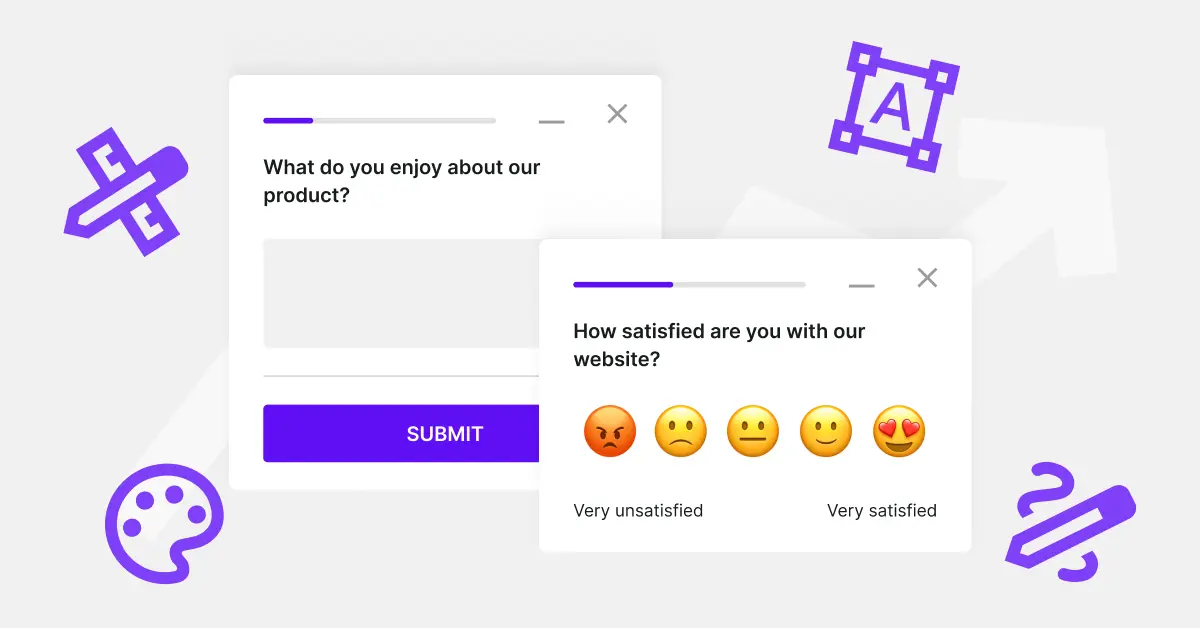
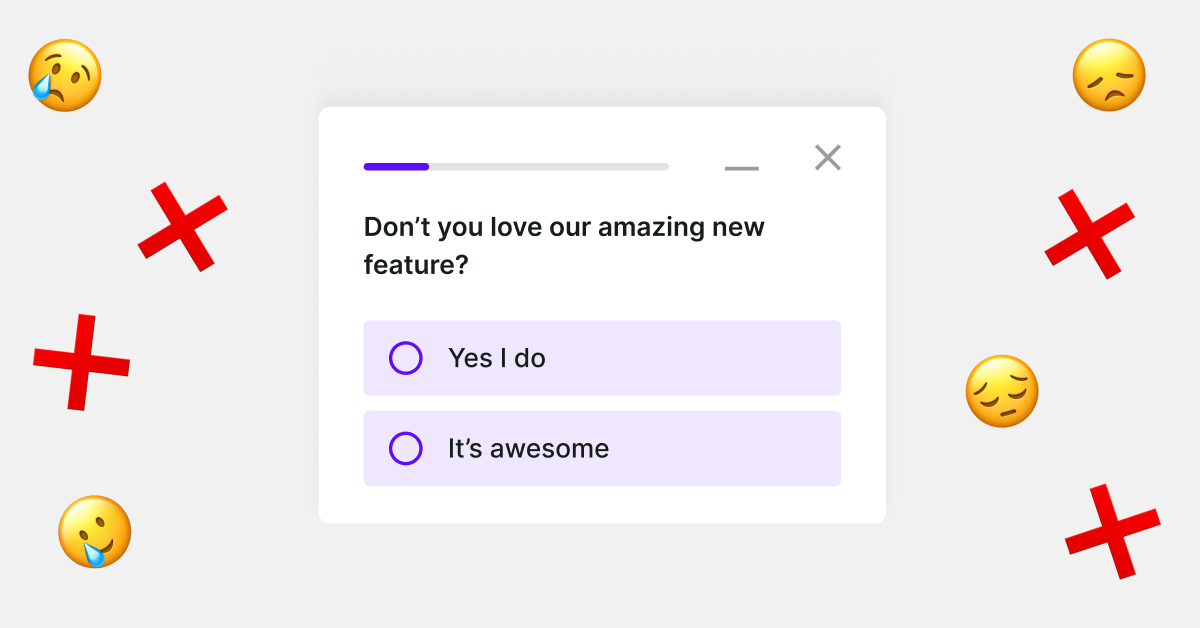
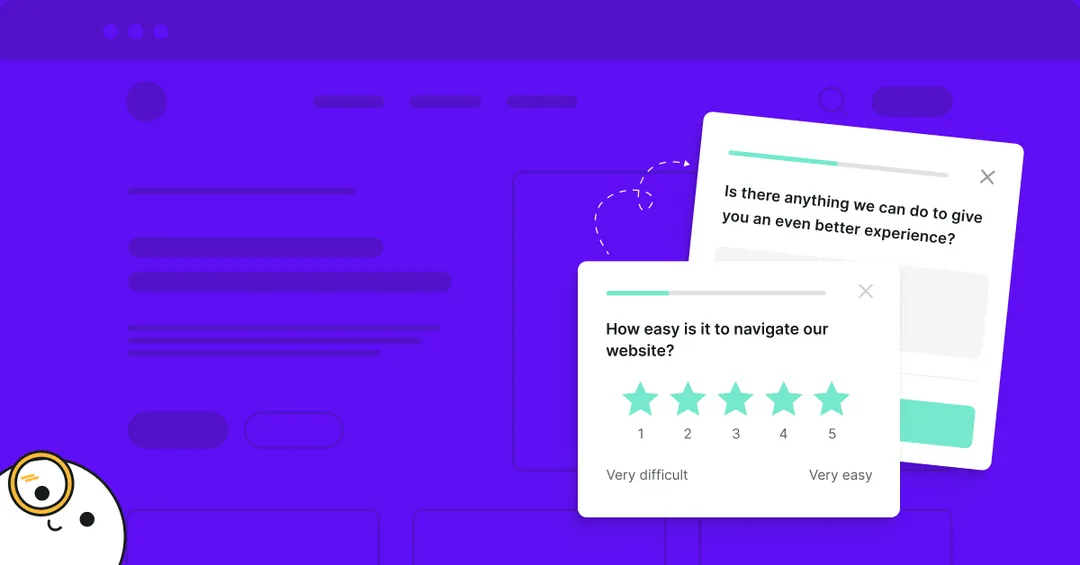

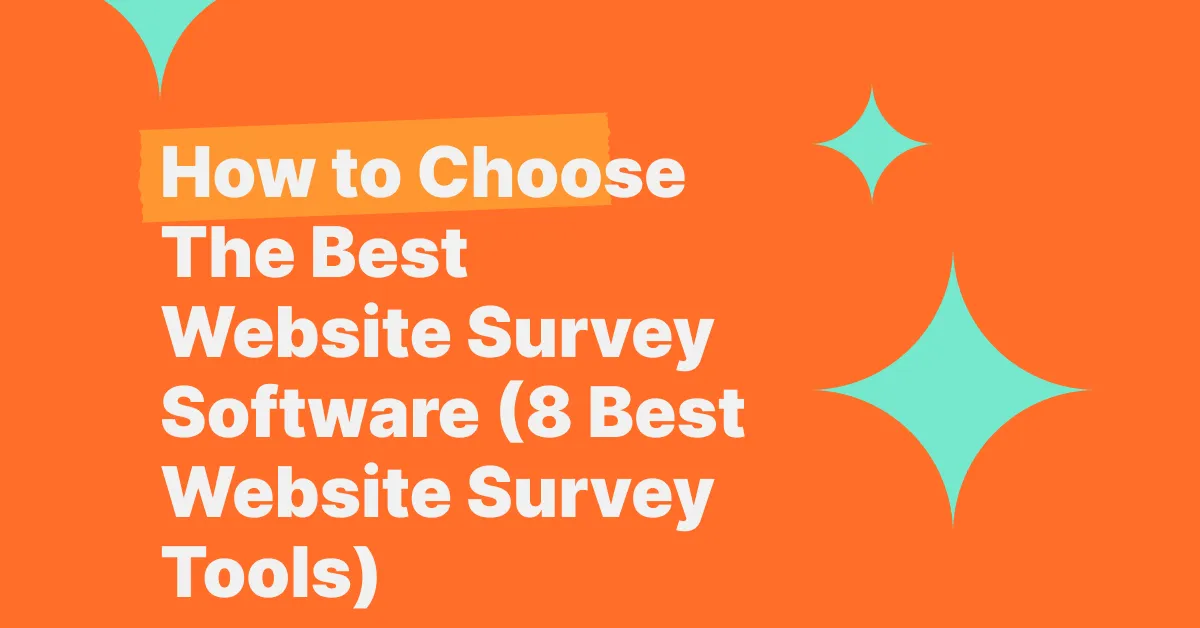
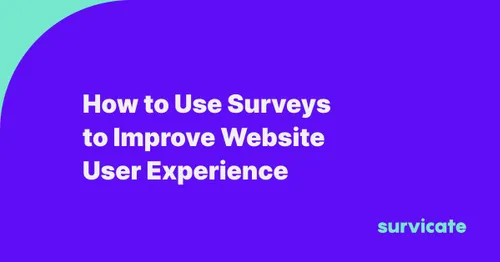
.svg)

.svg)



